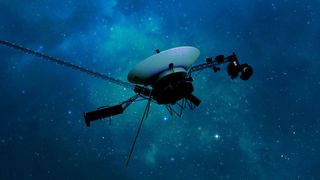SPACE
After months of sending gibberish to NASA, Voyager 1 is finally making sense again
By Sascha Pare published 5 hours ago
NASA's Voyager 1 probe has resumed sending usable data back to Earth after engineers fixed a computer error that caused the interstellar spacecraft to only transmit gibberish for five months.

By Sascha Pare published 5 hours ago
NASA's Voyager 1 probe has resumed sending usable data back to Earth after engineers fixed a computer error that caused the interstellar spacecraft to only transmit gibberish for five months.

NASA’s Voyager 1 spacecraft is depicted in this artist’s concept traveling through interstellar space, or the space between stars, which it entered in 2012. (Image credit: NASA/JPL-Caltech)
NASA's Voyager 1 probe is once again sending readable radio signals back to Earth after engineers fixed a computer glitch that caused the spacecraft to malfunction in November.
For the first time in five months, Voyager 1 is now transmitting usable data about the health and status of its onboard engineering systems back to our planet, NASA's Jet Propulsion Laboratory announced Monday (April 22). However, engineers have yet to fix the software that enables the spacecraft to return science data.
Voyager 1 is cruising through interstellar space roughly 15 billion miles (24 billion kilometers) away from Earth, which means mission control teams have to wait 22.5 hours for their commands to reach the spacecraft and another 22.5 hours for a response. Voyager 1 and its twin probe — Voyager 2, which continues to operate normally after a 2-week blackout last year — were launched almost 47 years ago and are the most distant human-made objects in existence.
Engineers first noticed something wrong with Voyager 1 on Nov. 14, 2023, when the probe suddenly began transmitting a nonsensical stream of ones and zeros instead of its usual neatly packaged science and engineering datasets.
Mission controllers could tell the spacecraft was still receiving their commands, however, indicating that its vital systems were operating normally.
Related: A mysterious 'hum' vibrates interstellar space. Voyager 1 has a recording of it.
In early March, after three months of unsuccessful tinkering, NASA engineering teams determined the issue was tied to one of Voyager 1's three onboard computer systems known as the "flight data subsystem" (FDS). The FDS is essential for packaging data harvested by the probe before they are sent to Earth, according to NASA's announcement.
Sign up for the Live Science daily newsletter now
Get the world’s most fascinating discoveries delivered straight to your inbox.Contact me with news and offers from other Future brandsReceive email from us on behalf of our trusted partners or sponsorsBy submitting your information you agree to the Terms & Conditions and Privacy Policy and are aged 16 or over.
Engineers located the glitch by sending a command — or "poke" — that prompted the FDS to try new sequences of code in its software in case the issue could be resolved by skirting a corrupted section. The command triggered a signal that differed from the stream of gibberish the spacecraft had been sending back, and that engineers were able to decode.

After receiving data about the health and status of Voyager 1 for the first time in five months, members of the Voyager flight team celebrate in a conference room at NASA’s Jet Propulsion Laboratory on April 20. (Image credit: NASA/JPL-Caltech)
It turned out a single chip responsible for storing a portion of the FDS memory, including some of its computer software code, had stopped working. The loss of that code meant the probe's science and engineering data were unusable, according to NASA. To get around the issue, engineers broke up the code once stored in the chip and squeezed sections of it into functioning portions of the FDS memory.
—Historic space photo of the week: Voyager 2 spies a storm on Saturn 42 years ago
The team then rewrote some of the reshuffled code so it could work as a whole again.
Engineers saved these modifications to the FDS memory on April 18. Two days later, they received a response from Voyager 1 showing that the reshuffle worked. For the first time in five months, the probe's message contained readable data, prompting celebrations at the Jet Propulsion Laboratory in Southern California.
However, solving the spacecraft's science data transmission will take further mending of the corrupted portions of the FDS software, NASA said in its announcement.
NASA's Voyager 1 probe is once again sending readable radio signals back to Earth after engineers fixed a computer glitch that caused the spacecraft to malfunction in November.
For the first time in five months, Voyager 1 is now transmitting usable data about the health and status of its onboard engineering systems back to our planet, NASA's Jet Propulsion Laboratory announced Monday (April 22). However, engineers have yet to fix the software that enables the spacecraft to return science data.
Voyager 1 is cruising through interstellar space roughly 15 billion miles (24 billion kilometers) away from Earth, which means mission control teams have to wait 22.5 hours for their commands to reach the spacecraft and another 22.5 hours for a response. Voyager 1 and its twin probe — Voyager 2, which continues to operate normally after a 2-week blackout last year — were launched almost 47 years ago and are the most distant human-made objects in existence.
Engineers first noticed something wrong with Voyager 1 on Nov. 14, 2023, when the probe suddenly began transmitting a nonsensical stream of ones and zeros instead of its usual neatly packaged science and engineering datasets.
Mission controllers could tell the spacecraft was still receiving their commands, however, indicating that its vital systems were operating normally.
Related: A mysterious 'hum' vibrates interstellar space. Voyager 1 has a recording of it.
In early March, after three months of unsuccessful tinkering, NASA engineering teams determined the issue was tied to one of Voyager 1's three onboard computer systems known as the "flight data subsystem" (FDS). The FDS is essential for packaging data harvested by the probe before they are sent to Earth, according to NASA's announcement.
Sign up for the Live Science daily newsletter now
Get the world’s most fascinating discoveries delivered straight to your inbox.Contact me with news and offers from other Future brandsReceive email from us on behalf of our trusted partners or sponsorsBy submitting your information you agree to the Terms & Conditions and Privacy Policy and are aged 16 or over.
Engineers located the glitch by sending a command — or "poke" — that prompted the FDS to try new sequences of code in its software in case the issue could be resolved by skirting a corrupted section. The command triggered a signal that differed from the stream of gibberish the spacecraft had been sending back, and that engineers were able to decode.

After receiving data about the health and status of Voyager 1 for the first time in five months, members of the Voyager flight team celebrate in a conference room at NASA’s Jet Propulsion Laboratory on April 20. (Image credit: NASA/JPL-Caltech)
It turned out a single chip responsible for storing a portion of the FDS memory, including some of its computer software code, had stopped working. The loss of that code meant the probe's science and engineering data were unusable, according to NASA. To get around the issue, engineers broke up the code once stored in the chip and squeezed sections of it into functioning portions of the FDS memory.
—Historic space photo of the week: Voyager 2 spies a storm on Saturn 42 years ago
The team then rewrote some of the reshuffled code so it could work as a whole again.
Engineers saved these modifications to the FDS memory on April 18. Two days later, they received a response from Voyager 1 showing that the reshuffle worked. For the first time in five months, the probe's message contained readable data, prompting celebrations at the Jet Propulsion Laboratory in Southern California.
However, solving the spacecraft's science data transmission will take further mending of the corrupted portions of the FDS software, NASA said in its announcement.
Agence France-Presse
April 23, 2024

NASA's Voyager 1
NASA's Voyager 1 probe -- the most distant man-made object in the universe -- is returning usable information to ground control following months of spouting gibberish, the US space agency announced Monday.
The spaceship stopped sending readable data back to Earth on November 14, 2023, even though controllers could tell it was still receiving their commands.
In March, teams working at NASA's Jet Propulsion Laboratory discovered that a single malfunctioning chip was to blame, and devised a clever coding fix that worked within the tight memory constraints of its 46-year-old computer system.
"Voyager 1 spacecraft is returning usable data about the health and status of its onboard engineering systems," the agency said.
"The next step is to enable the spacecraft to begin returning science data again."
Launched in 1977, Voyager 1 was mankind's first spacecraft to enter the interstellar medium, in 2012, and is currently more than 15 billion miles from Earth. Messages sent from Earth take about 22.5 hours to reach the spacecraft.
Its twin, Voyager 2, also left the solar system in 2018.
Both Voyager spacecraft carry "Golden Records" -- 12-inch, gold-plated copper disks intended to convey the story of our world to extraterrestrials.
These include a map of our solar system, a piece of uranium that serves as a radioactive clock allowing recipients to date the spaceship's launch, and symbolic instructions that convey how to play the record.
The contents of the record, selected for NASA by a committee chaired by legendary astronomer Carl Sagan, include encoded images of life on Earth, as well as music and sounds that can be played using an included stylus.
Their power banks are expected to be depleted sometime after 2025. They will then continue to wander the Milky Way, potentially for eternity, in silence.
April 23, 2024

NASA's Voyager 1
NASA's Voyager 1 probe -- the most distant man-made object in the universe -- is returning usable information to ground control following months of spouting gibberish, the US space agency announced Monday.
The spaceship stopped sending readable data back to Earth on November 14, 2023, even though controllers could tell it was still receiving their commands.
In March, teams working at NASA's Jet Propulsion Laboratory discovered that a single malfunctioning chip was to blame, and devised a clever coding fix that worked within the tight memory constraints of its 46-year-old computer system.
"Voyager 1 spacecraft is returning usable data about the health and status of its onboard engineering systems," the agency said.
"The next step is to enable the spacecraft to begin returning science data again."
Launched in 1977, Voyager 1 was mankind's first spacecraft to enter the interstellar medium, in 2012, and is currently more than 15 billion miles from Earth. Messages sent from Earth take about 22.5 hours to reach the spacecraft.
Its twin, Voyager 2, also left the solar system in 2018.
Both Voyager spacecraft carry "Golden Records" -- 12-inch, gold-plated copper disks intended to convey the story of our world to extraterrestrials.
These include a map of our solar system, a piece of uranium that serves as a radioactive clock allowing recipients to date the spaceship's launch, and symbolic instructions that convey how to play the record.
The contents of the record, selected for NASA by a committee chaired by legendary astronomer Carl Sagan, include encoded images of life on Earth, as well as music and sounds that can be played using an included stylus.
Their power banks are expected to be depleted sometime after 2025. They will then continue to wander the Milky Way, potentially for eternity, in silence.
No comments:
Post a Comment